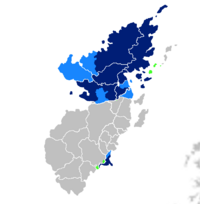Seketese language
| Seketese | |
|---|---|
| Secéteça | |
| Ethnicity | Seketese people |
Native speakers | 6.3 million (2016) 6.9 million total speakers L2 speakers: 650,000+ |
| Latin (Seketese alphabet) Seketese Braille | |
| Official status | |
Official language in | |
Recognised minority language in | |
| Regulated by | Académie Secéteça (Seketese Academy) |
| Language codes | |
| ISO 639-3 | SEK |
 Regions where Seketese (including Luderanese) is predominant and official
Regions where Seketese is official
Regions where Seketese is a predominant and not official | |
Seketese is a North Nelbec language of the Secenic branch spoken by the Seketese people. It is the official language of Seketan and a recognized language in Alquiya, Lormotia, and New Svealand.
Old Seketese emerged from the prestige dialect of Old Secenic from within the Secenic Confederation, becoming the dominant working language of the Kingdom of Seketan which emerged in the late medieval period. The language became the official and literary language of the kingdom, where Old Seketese literature was primarily produced by the clergy. The language became heavily influenced by the Germanic languages and French, resulting in a diverse vocabulary, simplified orthography similar to French, and the disappearance of an inflected case system.
Seketese is written in the Seketese alphabet using the Latin script. Modern Seketese was first codified in 1750 and was most recently reformed in 1924, however regional variant spellings are typically accepted as acceptable. Seketese is the native tongue of 6.3 million people and is widely spoken in Seketan, Falanda in New Svealand, Luderan in Lormotia, and Seketese diaspora communities.
Classification
Seketese is part of the North Nelbec branch of the Nelbec languages. In its understood classification, Seketese is a Secenic language, alongside Fjeskan, but is separated from the Wilsk language, spoken in Wilskland, a province of Seketan. By the criteria of mutual intelligibility, Seketese resembles other North Nelbec languages, but is further separated from Wilsk, a language that is generally not understood by a majority of native Seketese speakers.
Geographic distribution
Speakers of the Seketese language are primarily concentrated in the Nelborne. As the national language of Seketan, Seketese is predominant in areas with strong connections to the country. Most of Seketan, outside of Fjeska and Wilskland, is Seketese-speaking. The language is also spoken in areas outside of Seketan where Seken minorities are present. The southern Lormotian province of Luderan has a large amount of Seken descended inhabitants who speak Luderanese. The Svealandic territory of Fålanda, adjacent to the province of Fjeska, has a significant amount of Seketese speakers. Seketese-speaking communities sporadically exist in northern regions of Alquiya. Seketese is spoken in many diaspora communities, primarily in Canada and the United States.
Official status
Seketese is the official language of the Republic of Seketan. It is an official language of the Autonomous Province of Fjeska alongside Fjeskan and Svealandic, and de facto official in every province except Wilskland.
Seketan is a recognized minority language in Alquiya, Lormotia, and New Svealandic. The language is an recognized language in Luderan and Fålanda, in Lormotia and New Svealand respectively.
Dialects
The Seketese language is spoken through various dialects, all with varying levels of mutual ineligibility ranging from a change in accent to complete intelligibility. Standard Seketese is based primarily on the Gjenoreça dialect with modified features, and is the primary dialect of Seketan.
Bynanese is a recognizable dialect spoken in Bynan.